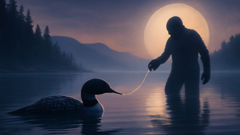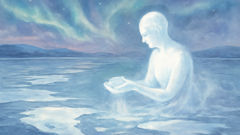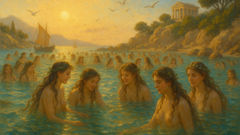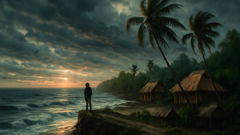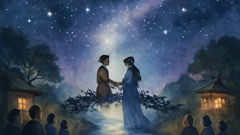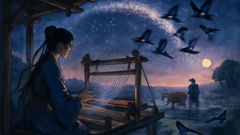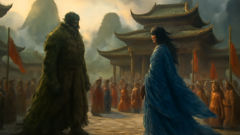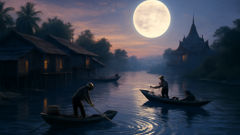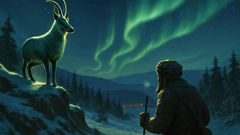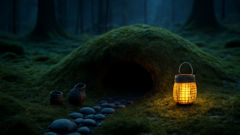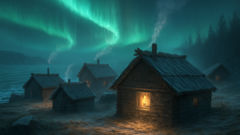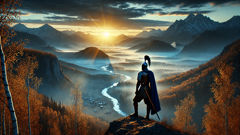Introduction
Beyond the line where white birches stop whispering and the land surrenders to a silence wide as sky, the Tungusic people tell a first story. In that tale the world did not begin with mountains or trees, nor with people and fires, but with a sea so broad and still that the horizon folded like the edge of a dream. Above it, the sky hung like a calm drum, and below it, darkness kept company with hushed possibility. Before earth was fixed beneath feet the maker Buga walked that edge, unseen and known, feeling for thought itself. Birds circled the emptiness and called to nothing. One of them, a loon with eyes like black glass and feathers that held the sheen of ice, saw the deep and heard the quietness there. The loon, small and stubborn, held a kind of knowing people call old-wisdom; it understood that something must be brought up to give the sky a partner. Buga, who is more breath than body and more mercy than thunder, bowed to the loon and offered a thread of power—gentle, patient, woven of song and stone. Together they would make the first land. So begins the story the elders tell by firelight, the one that names why rivers run and why loons answer the moon. It is a tale of return and rescue, of an animal who learns the weight of the world, and of a god who shapes his kindness into a rope light enough for a bird and strong enough to hold the earth. If you listen close, in weathered voices and in young mouths, you can hear the loon’s paddles in the water yet, and in that sound the rumble of creation.
The Deep and the Decision
When the world was not yet a world, the sea kept everything in its dark palms. It was not angry water but a patient, endless blank, like the inside of a drum that had not yet been struck. There was no weather as folk know weather; no wind threaded through leaves, for leaves did not exist. Only the quiet and the loon. The loon had once been one of many birds, feathers bright and bill straight, skimming the emptiness for shapes of thought. It watched the sky’s reflection and grew uneasy at how nothing answered back. In the long hush something inside the loon began to thrum: a wanting to fetch, to bring, to bridge.
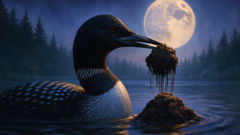
At first the loon peered and paddled, touching small ripples that vanished into the huge calm. It dove for pebbles of thought, for memories lost in the deep; sometimes it returned with nothing but a drop of cold that smelled of silence. The elders say the loon was not proud, yet it was stubborn: it kept returning, again and again, each plunge an act of petition. Buga watched from the shore. Not a god of wrath or iron, Buga is a maker who prefers to coax rather than command; he knows the language of creatures and the way small beings carry great courage. He had watched other hopeful birds fail, watched tiny paws and beaks strike the surface and come back empty. Buga understood that the deep would not yield to force; it required trust and a mind willing to change.
So Buga offered the loon a thin strand of his will—a thread as fine as moonlight and as strong as old roots. It was not a rope to bind but a song to guide: when the loon would clutch it, the thread would sing in tune with the deep and lead the bird to places where the sea forgot its own teeth. The loon accepted. Its heart was heavy with a fear that felt like salt, but the calling in its bones was fiercer still. With Buga’s single, whispered counsel, the loon learned a new skill: how to slow itself into silence so the deep would not be tempted to swallow its courage.
The first dive was slow and ceremonial, like the first note of a long melody. The loon arched, pinched the thread between its webbed toes, and slipped beneath the surface. For a heartbeat the world condensed into a black drumskin; then cold wrapped the loon like a cloak. The water did not try to stop the bird. It felt the loon’s resolve and, curious, let it go. The loon swam with all the might it did not know it had, deeper than other birds had ever dared. It found not just mud or stone but the memory of things that might be—soft clots of matter that held warmth and peat and the ghost of seeds. These things clung to its beak and feet with a softness that startled the bird: they were not empty but full of possible green and growth.
Still, the deep has tricks. It stretches and contracts like the chest of a sleeping giant. Just as the loon felt the weight of its cargo become unbearable, the sea gave a sudden, quiet roll and the thread hummed. Buga, who had not left the shore, began a low chant—no thunder, only bent reeds of syllable that wove themselves into the line guiding the loon upward. Wave by wave, breath by breath, the loon rose through the dark, the thread pulling as if by compassion. When the loon breached, it was like a stone punched through a sleeping skin: a tear in the plain surface that let air rush in and fill lungs anew. The bird emerged, dripping with the sticky, warm earth it had gathered, and the shore trembled at the weight of potential.
The first earth smelled of wet root and the inside of caves; it was cool and stubborn. Buga set a palm on the offering and hummed a making-song, an old, patient melody that teased seed into being and called for shape. The loon, exhausted and triumphant, clipped the thread from the maker’s hand and watched Buga press that clump of dark into a spread of water. Where Buga placed it, the water receded and a small, firm island appeared like a thought given a body. The loon, unaccustomed to being praised, bobbed and called—a thin, joyous cry that echoed across the newborn plain. Creatures that had been only shadows in the deep felt the new firm ground and came forward: roots that were not yet roots, a moss that dreamed of sunlight, and, later, river-songs that remembered their routes.
This was no single instant of wonder but the beginning of a long work. Buga guided the loon to return, and the loon dove again and again. Each time it brought up more of the deep’s memory—silt heavy and glittering with minerals, a pebble that would become a mountain’s seed, a sliver of blackish sand that would turn into the color of a raven’s wing. The loon's dives were small miracles, each one a stitching that mended emptiness into habitable shape. As the land grew, so did the loon’s story among the newly rooted things. The loon became both maker and messenger: a living testament that a small creature with a steady heart can change the face of the world.
People born later would call the loon stubborn and wise in the same breath. Artists painted it in ceremonial garments of fur and feather; shamans found in its dive an image of their own journeys between worlds. But the tale keeps a quiet truth: creation was neither a flash of power nor a single brute motion. It was a conversation between depth and bird and a god who offered what could not be taken by force. When you stand beside a northern lake and watch a loon cut the air and sing into the dusk, remember that song carries the echo of that first dive. The loon’s insistence and Buga’s soft authority braided the world together, and every river that now unrolls through valley remembers it.
Shaping the Land: Buga’s Hands and the Loon’s Return
After those first births of land, the work of shaping began. Buga did not hoard the making; he invited other beings and taught them tasks. Wolves were given the job of testing the bounds of the land—how far a foot might press before it surrendered to a new kind of soft plain. Stones were coaxed until they took stubborn, patient shapes, forming the first ridges where winter would later bite and hold. Plants were sung into patient growth; grasses learned to hold snow like a soft blanket. But always, the loon was the one who dove. It had become both a vessel and an oath: its dives were vows that the world should keep giving and that the deep would keep willing to give.
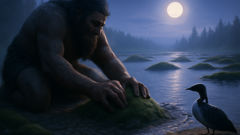
Each return from the deep taught the loon more about what the surface required. Sometimes it came back with clumps that smelled of salt and iron and were too heavy to place as island; Buga would take those, grind them between the great stones of his hands, and spread them into plains that soaked up wind and became steppe. Other times the loon retrieved glittering shards that would become pebbles for riverbeds, and Buga would roll them into the channels where waters could slap their edges with music. The maker worked slowly, making hollows for lakes where singing could collect and giving hollows small mouths to let rivers begin their long journeys. In every motion there was intention: an ear of land to listen for rain, a shoulder of hill to bear forests.
The loon learned that the deep had moods. There were times when the water grew thick and quick, and loaves of mud would cling to the loon’s throat like grief. At other times the deep loosened and let the bird carry away soft pillows of peat. Buga, who felt pity like weather, did not push. He taught the loon to sing before diving, to call into the dark with a voice that asked rather than took. Often it is said the thread of power Buga gave was more than magic; it was instruction in humility. The loon’s songs changed too: once sharp and single-minded, then becoming more complex, turning into a weave of notes that asked the sea for small things—stones, a handful of warmth, a lump of memory. Through that conversation the deep began to give what the land needed most: variety. It offered clay for future potters, tiny grit for future rivers to grind, and dark, sweet places where seeds could learn to sleep.
As land took shape, the first communities of life began to appear, not yet people but beginnings: mosses learning to hold dew, insects that grazed the new greens, and fish that remembered their new rivers. The loon grew famous, and tales of its dives traveled by song. Shamans traced the loon’s path in ritual and claimed to follow its dives in trance. They would recount how Buga—gentle as smoke—would stand by and, at critical moments, press his palm into the forming earth so that hills could take a slow slope and not a sheer fall. Sometimes Buga’s hands trembled, for even a maker can be surprised. The sea occasionally offered a heavy stone so dense that it would make an island too fast and too steep. In those moments Buga softened the stone with songs of wind and river, and the loon would search for peat and softer things to cushion the sharpness.
People, when they finally walked these places, learned to look for the loon’s signature. A certain sweep of shore, a pattern in the reeds, a rounded pebble—each was a signature of a specific dive. Mothers pointed out the spots of shallow water where the loon had first dragged up a wedge of soil, and children hunted for smooth stones that might have been the first riverbeds. In winter, when the world closed into white and breath, the story would be told again beside fires, keeping warm the knowledge that the world had been wrought not by a single crown of power but by many small acts and many returns. The loon became a totem for those who travel between worlds. Hunters who needed a path through ice would whisper the loon’s chant. Midwives would call its steady note when they needed to coax a child into being. The bird’s dives echoed in rites of passage and in prayers for mercy.
And yet the loon’s most important lesson to humankind was this: cooperation without domination can alter the shape of things. Buga asked, the loon answered, the sea gave what it could, and the land learned to forgive and to hold. Creation was collaborative—and so survival would be too. Where folk harvested fish or gathered berries they did so mindful of this origin; taking too much, they believed, could anger the deep; taking with song and thanks kept a balance. Sacred meadows were left uncut, and lakes were circled by elders who gave gifts into the water and called the loon's name as thanks. In that way a moral life emerged from the origin myth: humility toward the unseen, respect for small things, and recognition that even the smallest creature could hold up the world.
As the ages wove themselves into sleep and waking, the loon continued to patrol lakes and river mouths, diving still when called by dreamers and shamans. Buga’s presence grew quieter; he became the hush beneath the wind, the patience in a birch’s growth. But his gift remained—woven into songs and rituals, into the thread of ceremony that tied makers to made. The story of the loon’s dives remained a map for how to live: persist, ask, accept help, and return. This myth, kept alive by breath and fire, taught a people to be careful with their feet on the earth the loon brought forth. In every ripple and reed, the memory of that first dive and that gentle god’s hand still spoke. The land, when wind passed over it, sometimes seemed to chant back.
Conclusion
So the story is kept: not as a tidy doctrine but as a living map for how to be in a world that is both gift and task. The loon, humble and steadfast, taught that courage is often the patience to try again, the willingness to sink and to hold on, while Buga showed that kindness can be a form of power, shaping without crushing. From their work came rivers that learned the names of stones, forests that remember footfalls, and people who learned to give thanks when they took. When you visit a northern lake and see a loon cut the dusk—listen. In that sound are echoes of dives that braided earth and water together, and in the quiet afterward you can hear the maker’s soft song. Keep that sound with you; let it remind you that creation is a conversation and care is the most ancient magic. Live softly upon the gifts you did not make alone, and remember to sing your thanks back to the deep.

